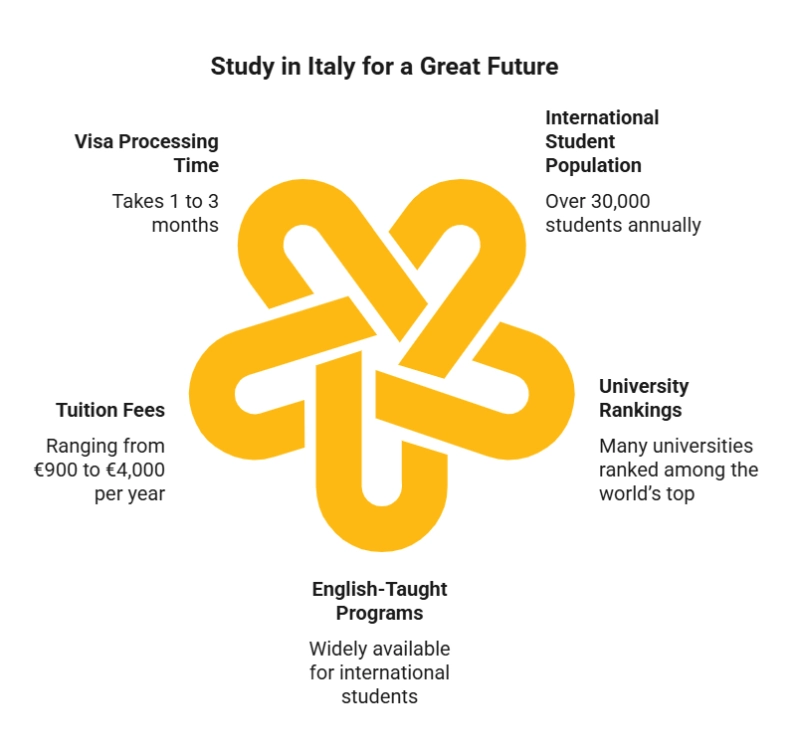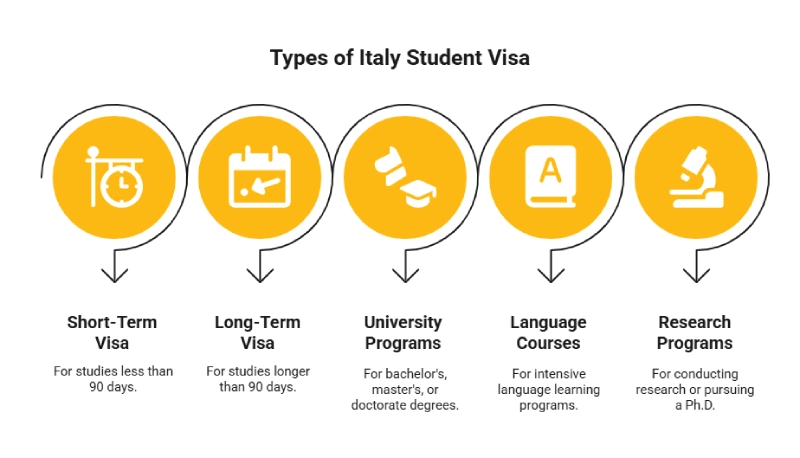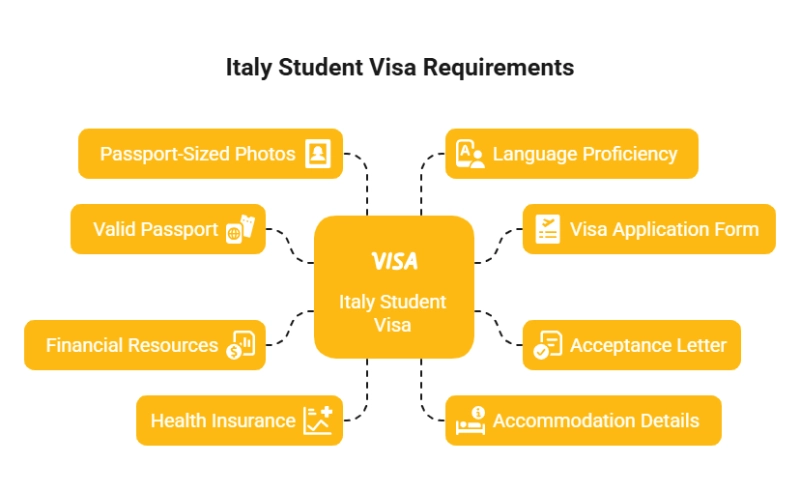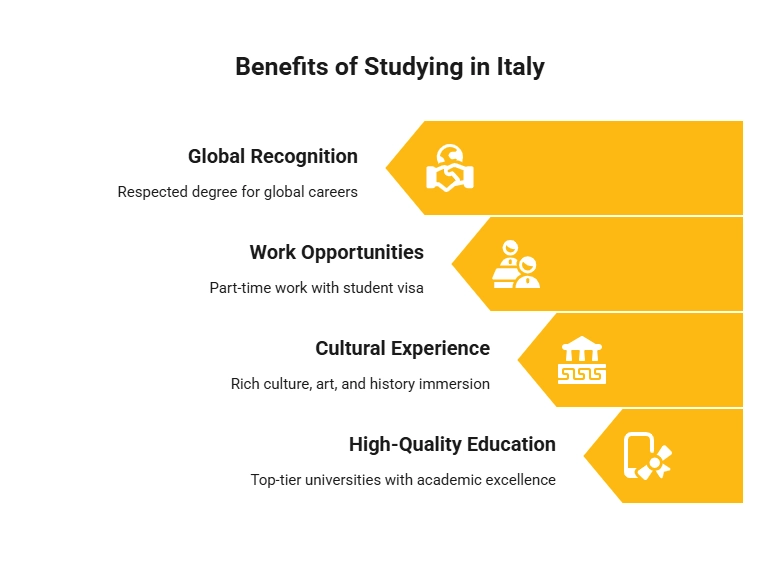
Studying in Italy gives you a chance to receive a global education in a country with a rich culture. Italy hosts some of the world's best universities and offers many programs for students from other countries. If you want a quality education in a country with a long history, Italy is a great place to go.
For students from outside the EU wanting to study in Italy, an Italy Student Visa is a must. It gives you the legal permission to attend an Italian university and lets you enjoy Italy's culture and student scene. The visa also gives you access to important services like healthcare during your time there.
The Italy Student Visa lets students work part-time usually up to 20 hours a week while classes are in session. This can help you pay for living costs and get work experience in Italy.
Living and studying in Italy is a chance to see historical places, well-known art, and modern teaching methods. This international experience can greatly help you grow, both personally and professionally.
*Need assistance to study abroad? Talk to Y-Axis for complete guidance.
If you're an international student from outside the EU and want to study in Italy for longer than 90 days, you'll need an Italy Student Visa. With this visa, you can sign up for courses at Italian universities, go to class, and join activities outside of school. It lets you really get involved in student life there.
Italy's universities offer four main categories of courses:
Italy follows the Bologna system, which is common across European countries, ensuring a standardized and high-quality education framework.
There are numerous renowned universities in Italy, such as Sapienza University of Rome, where you can pursue a variety of academic programs. Throughout the application process, our consultants assist you in selecting the best university in Italy that suits your academic and career goals.
Italy has different student visas based on how long you plan to study and what level of education you're pursuing. Here are the main ones:

Each student visa has different needs, like proof of funds, health coverage, language skills, and housing. Make sure you confirm the correct visa type based on how long your program lasts.
Italian Language Requirement
When applying, depending on your program, you might have to show that you know Italian. If your course is in Italian, the university will probably want proof that you have a certain level of Italian skills. But if you're taking a course in English, you'll usually need to prove your English skills instead, like with an IELTS or TOEFL test.
Student Accommodation and Living Costs
In Italy, lodging options for students range from university housing to private apartments, and costs depend on how much you want to spend and what you like. Most students should expect to spend between €700 and €1,200 each month for rent, food, travel, and personal expenses. Expenses can change based on the city; living in bigger cities, such as Rome or Milan, will probably cost more than smaller towns.
Italy has many well-known universities that offer courses in both English and Italian. Some of the best include:
| University | QS Rank 2024 |
| Politecnico di Milano | 123 |
| Sapienza University of Rome | 134 |
| Alma Mater Studiorum - University of Bologna | 154 |
| Università di Padova | 219 |
| Politecnico di Torino | 252 |
| University of Milan | 276 |
| University of Naples - Federico II | 335 |
| University of Pisa | 349 |
| University of Florence | 358 |
| University of Turin | 364 |
Italian universities offer a wide variety of courses for international students, such as:
Social Science & Humanities:
Italy has 2 study intakes annually. International students can select any of the intakes according to their preference:
| Intake | Month | Description |
| Fall Intake | September | The primary intake for most programs. |
| Spring Intake | February | Available for select programs, especially for English-taught courses. |
Italian universities mostly admit students in September. Depending on the program, a few schools might also admit students in January or February. Applying six to eight months beforehand raises your chance of getting accepted and getting a scholarship.
| Higher Study Options | Duration | Intake Months | Deadline to Apply |
| Bachelors | 3 Years | Sep (Major) & Feb (Minor) | 6-8 months before the intake month |
| Master's (MS/MBA) | 2 Years |
In 2025, non-EU citizens will likely pay around €116 for an Italy Student Visa. You’ll need to pay this when you apply, and keep in mind that it's non-refundable if your application isn't approved. The exact cost could change a bit depending on where you’re from and the exact visa type you need. To get the correct fee for your situation, it’s best to check with the Italian consulate or embassy closest to you. Make sure to pay the fee when you submit your application.
To be eligible for an Italy Student Visa, you must meet the following requirements:
When applying for an Italy Student Visa, the required documents include:

Note: All documents must be submitted to the nearest Italian consulate or embassy.
Studying in Italy offers numerous benefits:

To apply for an Italian student visa, you need to take certain steps. Please follow this guide to make sure you meet all requirements.
Step 1: Get Accepted to a University
To apply for an Italy Student Visa, you should first get accepted to an Italian university. You'll need an acceptance letter or offer from a school that's approved. This letter is really important for your visa application; it proves you're enrolled in a program there.
Step 2: Gather Required Documents
After acceptance, prepare your visa application documents. These usually include:
Step 3: Submit Visa Application
Please submit your completed visa application to the closest Italian consulate or embassy in your country. Make sure to schedule an appointment beforehand, since many embassies have specific hours for visa applications. Remember to pay the visa fee and submit all the necessary documents with your application.
Step 4: Attend Visa Interview
You might need to go to a quick visa interview at the consulate or embassy. They’ll ask you about your study plans, what course you're taking, and how you're paying for it. Make sure you have all the details about your time in Italy ready to go.
Step 5: Wait for Approval
After you send in your application and complete the interview, if needed, you'll need to have patience as your visa goes through processing. The time this takes usually runs from one to three months. The reason is the number of applications to check, and the specific embassy. To make sure everything is in order, it's beneficial to submit your application early before your trip.
Step 6: Travel to Italy
After your Italy Student Visa is approved, you’re all set to go to Italy. Once you arrive, there are usually a few things you need to do, such as register with the local police or get your residence permit. Make sure you confirm exactly what’s needed with your school or the local government in Italy.
The fee for an Italian student visa typically ranges from €50 to €100. The exact cost varies depending on your nationality and the specific type of visa you need. You'll have to pay this fee when you submit your application, and keep in mind that it is non-refundable.
The Italy Student Visa typically takes one to three months to process, starting from your application date. Keep in mind that processing times can change based on how many applications are being processed and the specifics of your situation. So, it's a good idea to apply early before you plan to travel.
As a student in Italy, you are allowed to work up to 20 hours per week during the academic year and full-time during holidays if they have a proper work permit. This provides you with an opportunity to support yourself financially while gaining valuable work experience in Italy.
| Name of the Scholarship | Amount (Per Year) |
| EDISU Piemonte Scholarships | Up to €8,100 |
| Padua International Excellence Scholarship Programme | Up to €8,000 |
| Tuition Fee Waivers at the University of Pavia for International Students | Up to €8,000 |
| Bocconi Merit and International Awards | Up to €14,000 |
| Politecnico de Milano Merit-Based Scholarships for International Students | Up to €10.000 per year |
| Politecnico di Torino International Scholarships | Up to €8,000 |
| Università Cattolica International Scholarships | Up to € 5,300 |
Y-Axis can assist by giving more vital support to aspirants who wish to study in Italy. The support process includes,
Explore what Global Citizens have to say about Y-Axis in shaping their future
Canada PR Visa
Sameer got Permanent Resident Visa for C
Read More...
Canada Work Permit Visa
Varun provided us with great Y-Axis Revi
Read More...
Canada PR Visa
One of our client Virendra availing his
Read More...
Yes, international students from all over the world are welcome to study in Italy, provided they meet the entry requirements of Italian universities. Italy is home to a variety of public and private universities that offer programs at undergraduate, postgraduate, and doctoral levels. The country is renowned for its rich cultural heritage, world-class institutions, and innovative courses, particularly in fields such as arts, fashion, engineering, design, and business. Students can choose from numerous English-taught programs, making Italy a popular destination for students from non-Italian speaking countries. To study in Italy for more than 90 days, you must apply for a student visa, and make sure to meet academic, financial, and health insurance requirements. In addition to its academic offerings, Italy offers students the opportunity to experience a diverse culture and beautiful landscapes.
To study in Italy, international students need to fulfill a few key requirements:
Requirements to Study in Italy:
An Italy student visa is required for non-EU international students who plan to study in Italy for more than 90 days. This visa allows students to enroll in Italian universities, attend classes, and participate in academic and extracurricular activities. The visa application process includes submitting necessary documents, such as an acceptance letter from a recognized Italian university, proof of financial stability, health insurance coverage, and accommodation arrangements. Depending on your program, you may also need to demonstrate proficiency in either Italian or English. The student visa also permits students to work part-time (up to 20 hours per week) during their studies. Once approved, the visa allows students to live in Italy for the duration of their academic program, and it provides the opportunity to immerse oneself in Italy’s vibrant culture while pursuing higher education. The visa is typically valid for 1 year and can be renewed if necessary.
While studying in Italy is not completely free, the costs are generally lower compared to other countries, especially those in North America or the UK. Tuition fees at public universities in Italy typically range from €900 to €4,000 per year, depending on the institution and program. Private universities can have higher tuition fees. The costs also vary based on the city in which you study, as larger cities like Milan and Rome tend to have higher living expenses. However, Italy offers numerous scholarships and financial aid programs for international students, reducing the financial burden. Additionally, many students can work part-time during their studies, which helps with living expenses. Though the cost is not free, Italy remains one of the most affordable options in Europe for higher education, with the added benefit of offering high-quality programs in renowned institutions.
To study in Italy as an international student, first, you need to secure admission to an Italian university or academic institution. Once accepted, you must apply for an Italy student visa, which requires submission of documents like your acceptance letter, proof of financial resources (typically around €5,000 per year), health insurance, and accommodation proof. Depending on your course, you may need to prove proficiency in Italian or English. The visa application process also includes paying the application fee and providing biometric data. After your visa is approved, you can travel to Italy and begin your studies. Living in Italy as a student offers the opportunity to not only pursue high-quality education but also to experience Italy’s rich cultural and historical environment. Additionally, students in Italy can work part-time while studying, which helps with living expenses.
Italy offers a range of cities where international students can pursue their education. The most popular cities for students include Rome, Milan, Florence, and Bologna, each offering a unique experience. Rome is home to many historical landmarks and offers numerous universities, making it a popular choice for students. Milan is Italy's business and fashion capital, known for its design and fashion programs, as well as vibrant student life. Florence, renowned for its arts and history, is ideal for students interested in the humanities and culture. Bologna boasts one of the oldest universities in Europe and is famous for its dynamic student atmosphere. For students looking for lower living costs, cities like Padua and Turin are great alternatives. Ultimately, the best city to study in depends on the program you are pursuing, your budget, and the lifestyle you desire.
To obtain an Italy student visa, you must demonstrate that you have sufficient funds to support yourself during your stay. As of 2025, the general requirement for proof of financial means is about €5,000 to €6,000 per year. This amount ensures that you can cover your living expenses, including food, accommodation, and other daily costs. You may be required to provide bank statements or other financial documents showing that you have access to these funds. This is to ensure that students are financially self-sufficient during their studies. If you have a scholarship, sponsorship, or family support, that can also be used to demonstrate financial capability. Keep in mind that students studying in larger cities, such as Rome or Milan, might require more money due to higher living costs in those areas.
Studying in Italy offers an exciting opportunity to experience a rich cultural heritage while receiving a world-class education. Italy is home to some of the most prestigious universities in Europe, offering a wide range of courses in English and Italian. It is a hub for fields such as art, design, fashion, architecture, and engineering. Italy also provides a relatively affordable education compared to other European countries, with lower tuition fees and living costs. Moreover, the country’s historical landmarks, stunning architecture, and rich cultural traditions make it an ideal destination for students looking to immerse themselves in both academics and life experiences. Additionally, Italy offers job opportunities for international students to work part-time, and a student visa allows you to travel freely within the Schengen Area, offering an opportunity to explore other European countries.
The cost of studying in Italy varies depending on the university, course, and location. Public universities typically have lower tuition fees, ranging from €900 to €4,000 per year. Private universities, however, may have higher fees. For international students, the tuition fees are generally the same for EU and non-EU students. In addition to tuition, students need to budget for living expenses, including accommodation, food, transportation, and leisure activities. On average, students can expect to spend between €700 to €1,200 per month. The city you choose to study in plays a significant role in determining your living costs, with cities like Milan and Rome being more expensive compared to smaller cities like Padua or Turin. Scholarships and financial aid options are also available to help reduce costs.
Yes, it is possible to study in Italy without IELTS, especially if you’re enrolling in an English-taught program. Some universities in Italy offer alternative methods to prove English language proficiency, such as through a TOEFL score or other recognized tests. Additionally, some universities may waive the IELTS requirement if you have studied in English previously or come from an English-speaking country. It is essential to check the specific language requirements of your chosen Italian university, as each institution may have its own criteria for language proficiency. If you're applying for a course taught in Italian, you will likely need to provide proof of your proficiency in the Italian language, typically through a recognized language test or university assessment.
The processing time for an Italy student visa usually ranges from 3 to 8 weeks, depending on the applicant’s country and document verification speed.
An Italy student visa is typically issued for the duration of your study program, and you must apply for a residence permit (Permesso di Soggiorno) within 8 days of arriving in Italy.
Yes. International students can work up to 20 hours per week during their studies and full-time during holidays, provided they maintain valid student status.
After completing your degree, you can apply for a temporary stay permit (Permesso di Soggiorno per Attesa Occupazione) for up to 12 months to find a job in Italy.
The average cost of living ranges from €700 to €1,200 per month, depending on the city — with Rome and Milan being more expensive, and Bologna or Turin being more affordable.
Yes. Many universities and the Italian government offer scholarships like:
Italian Government Scholarships for Foreign Students
Invest Your Talent in Italy
University-specific merit-based grants
These can cover tuition, accommodation, or living expenses.
Most universities require an IELTS score of 6.0 to 6.5 for English-taught programs.
However, some institutions accept medium-of-instruction (MOI) letters instead of IELTS.
Yes. Students holding a valid long-stay visa can bring their spouse and children through a family reunification visa, provided they meet financial and accommodation requirements.
Yes. International students must have valid health insurance.
You can either:
Buy private health insurance, or
Enroll in the Italian National Health Service (SSN) for comprehensive coverage.
Some of the most prestigious universities include:
University of Bologna
Sapienza University of Rome
University of Milan
Politecnico di Milano
University of Padua
LUISS University